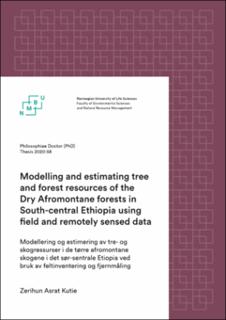| dc.contributor.advisor | Gobakken, Terje | |
| dc.contributor.advisor | Eid, Tron | |
| dc.contributor.advisor | Næsset, Erik | |
| dc.contributor.advisor | Ørka, Hans Ole | |
| dc.contributor.advisor | Negash, Mesele | |
| dc.contributor.author | Kutie, Zerihun Asrat | |
| dc.coverage.spatial | Ethiopia | en_US |
| dc.date.accessioned | 2023-02-24T12:29:44Z | |
| dc.date.available | 2023-02-24T12:29:44Z | |
| dc.date.issued | 2020 | |
| dc.identifier.isbn | 978-82-575-1725-0 | |
| dc.identifier.issn | 1894-6402 | |
| dc.identifier.uri | https://hdl.handle.net/11250/3053878 | |
| dc.description.abstract | For effective forest management missions, the presence of accurate information about the forest resources is indispensable. However, the absence of such relevant information for most natural forests in Ethiopia have been challenging the success of management efforts. Lack of appropriate methods, models and data are usually the bottleneck for the availability of the required information. This thesis thus, aimed at identifying and evaluating methods and providing models and data required for estimating tree and forest resources to enhance forest management decision-making. In Paper I, suitability of satellite images for forest area and canopy cover estimation based on visual image interpretation was evaluated. PlanetScope, RapidEye and Sentinel-2 imageries were used under different forest conditions in Ethiopia. Promising results were obtained where the required forest area and canopy cover estimates of large forest areas can be determined with relatively less time than field-based survey. When choosing satellite images, the spatial resolution should be considered carefully. Particularly for densely forested areas finer resolution images should be used. Imageries with high temporal resolution enhance estimation results by offering relatively more cloud free images. In Paper II, models for quantifying basic tree biometric properties including total tree and section volumes were developed and wood basic density data for 30 tree species in Dry Afromontane forests of south-central Ethiopia were documented. The models and data may also be applied to other similar forests. In Paper III, aboveground tree biomass prediction options were assessed for the study sites. The newly developed models are accurate and flexible in application depending on the availability of data from forest inventory. Models developed previously elsewhere were evaluated on our data and generally large prediction errors were observed. Indirect biomass prediction option from volume, using biomass expansion factor and wood basic density, was also assessed and found to be less accurate than the direct method using the newly developed models. Finally, Paper IV assessed the use of satellite images of Landsat 8, Sentinel-2 and PlanetScope for biomass estimation. The biomass model developed in Paper III was used to calculate ground reference values for the 111 systematically distributed sample plots. As a first practical experience for this type of forest in Ethiopia, the possible best spectral and textural variables to be used in biomass prediction models were identified for the respective image types. Model-assisted aboveground biomass estimation method in all the three imageries cases improved estimation efficiency compared to the purely field-based estimation. The estimation efficiency gain from Sentinel-2 was much larger than the others. In general, though further research still required on some gap areas, the developed models along with documented data and evaluated methods in this thesis may have strong practical implications to enhance forest management decision-making including the implementation of REDD+ MRV programs in the Dry Afromontane forests in Ethiopia. | en_US |
| dc.description.sponsorship | WGCFNR ; The Norwegian Government | en_US |
| dc.language.iso | eng | en_US |
| dc.publisher | Norwegian University of Life Sciences, Ås | en_US |
| dc.relation.ispartofseries | PhD Thesis;2020:58 | |
| dc.rights | Attribution-NonCommercial-NoDerivatives 4.0 Internasjonal | * |
| dc.rights.uri | http://creativecommons.org/licenses/by-nc-nd/4.0/deed.no | * |
| dc.title | Modelling and estimating tree and forest resources of the Dry Afromontane forests in South-central Ethiopia using field and remotely sensed data | en_US |
| dc.title.alternative | Modellering og estimering av tre- og skogressurser i de tørre afromontane skogene i det sør-sentrale Etiopia ved bruk av feltinventering og fjernmåling | en_US |
| dc.type | Doctoral thesis | en_US |

